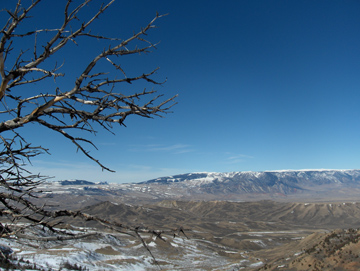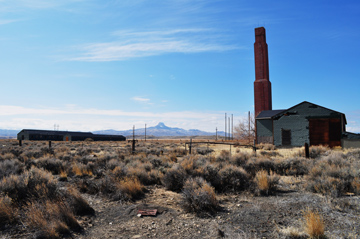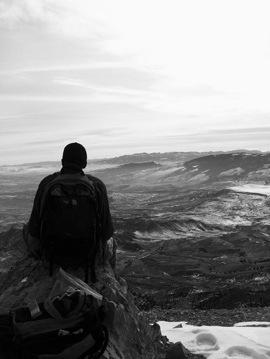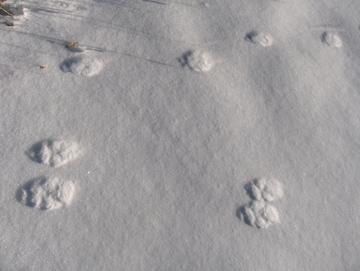Yellowstone National Park in northwest Wyoming has the distinction of being the first of its kind—a federally set-aside space meant for preservation and enjoyment by American and international visitors alike. Its geologic wonders and abundant wildlife attract millions of visitors each year. Some of the best kept secrets of the region, however, lay just outside Yellowstone’s borders. About sixty miles to the east of the national park, jutting out from the floor of an otherwise dry and desolate stretch of plain, is Heart Mountain. An extensive ring of mountain ranges encircle the Big Horn Basin, home to towns of Cody, Powell, and Clark, WY. A Japanese internment camp, Heart Mountain Relocation Center, once housed over 11,000 detainees during World War II. Its remnants rest at the foot of the towering rocky surface that shares its name.
 A view of the Big Horn Basin along the Heart Mountain Trail. Photo by Scott Slothower. |
The Heart Mountain Trail is a manageable six-mile hike up to the summit of Heart Mountain, which provides commanding views of the entire basin floor, encounters with wildlife, and exposure to many of the natural wonders of the region. How this towering craggy edifice, in the middle of the basin, was able to push its way nearly three thousand feet into the air has been a bone of contention to geologists for years. Of the limestone and dolomite that make up the mountain’s body, those whom scientists say were formed somewhere between 350 and 500 million years ago, the strata of its lower elevations are only a mere 55 million years old. Adding to the mysteriousness of an already rare geological wonder is the fact that somehow the older rock managed to do something of a geological role reversal. Anyone who has had an introductory class in geology can tell you that rock stratification seems to support the idea that older rocks are found at the bottom.
The native inhabitants and past residents of the area must have marveled at this mountain, perhaps considering it among the holy places for retreat, solace, and wonderment. Telltale signs of their dominance over these lands can still be found dotted throughout this extent of country. The great tribes of the Crow, Cheyenne, and Sioux told their stories on rock faces, left behind remnants of dwellings, ceremonial talismans, and roads on which they traveled. John Coulter, once a member of the Lewis and Clark expedition, was honorably discharged from the expedition and explored the sweeping vistas and valleys to the west of this location in what would eventually become the rauche jaune, the “yellow stone,” and the national park from whence its name originates. Buffalo hunter, showman, and entrepreneur, William F. Cody, otherwise known as “Buffalo Bill,” would attempt to tame this region, call it his own, and prepare it for mass settlement.
 Remnants of the Heart Mountain Relocation Center with Heart Mountain in the background. During WWII, the surround area housed nearly 11,000 Japanese and was considered the third largest human settlement in Wyoming at the time. Photo by Scott Slothower. |
Curious to see Heart Mountain from a different vantage point, my coworker, Scott Slothower, and I ventured there one mild January day. Like a lighthouse warning ships of an approaching craggy shoreline, Heart Mountain presides prominently over the entire town of Cody, WY, where we live. Cody sits at the base of the Absaroka Range and rests along the Shoshone River. Slightly to the northwest lay the Beartooth Mountains, whose rocky face serves as a barrier wall separating the flat stretches of the Big Horn Basin from Yellowstone and its geysers. Thirty miles to the east stands yet another mountain range, the barrier of which provides equal protection: the Big Horn Mountains. And then there is Heart Mountain, just standing in the middle of nowhere, like an orphan who can’t decide whether she belongs to the Beartooth Clan, The Absaroka Clan, or the Big Horn Clan. Heart Mountain, then, is somewhat of an ugly duckling.
Scott is a self-described immanent naturalist, photographer, and environmentalist who has explored many spots throughout the region in search of wildlife, rare geologic finds, and petroglyphs from inhabitants past. I am what you would call a run-of-the-mill hiker and nature lover, one who seeks the calm of the outdoors as a reprieve from noise and distractions. The inner monk in me seeks out nature to reconnect and find value.
We set out in search of all of these things and more. The weather had been rather balmy for this time of year in Wyoming, averaging about 40 degrees during the day. Wyoming winters can be quite brutal, especially for an East Coaster like me, who is not used to seeing temps drop below 20 degrees in the winter. Any native from Wyoming can tell you that the thermometer can plummet to -30 or more for weeks at a time in January. Despite the temperature, Old Man Winter managed to throw a couple of snowflakes our way, with a couple of inches of snow blanketing the mountain.
 Thomas taking a much-needed rest and snack break facing southwest at the summit of Heart Mountain. Photo by Scott Slothower. |
The road that leads to the Heart Mountain Trail is about 9 miles northwest of Cody on U.S. Hwy 14A. Turning left onto County Road 19, one first comes across a building that resembles a double wide trailer built of wood supports and an arched roof. The entrance to the building property is protected by a single chain and a gate. Still under construction, it will house the Heart Mountain Interpretive Center, a lasting testament to the now defunct Heart Mountain Relocation Center. Built in 1942, at the height of World War II hysteria, Heart Mountain Relocation Center housed nearly 11,000 Japanese-Americans and was considered to be the third largest community in the state at the time. Just around the corner from the Interpretive Center stands a memorial plaque dedicated to the internees and a half-mile paved loop trail pointing out where the residents lived, ate, and swam for the three years that the camp was in existence. Heart Mountain continues to loom in the background, just as it had in 1945 when the camp was disbanded.
Another six miles and signs to the Heart Mountain Ranch and trail become visible. A dirt road gives way to a four-wheel drive road with deep ruts and protruding rocks. A small flock of sage grouse, partially camouflaged by the sagebrush, waited patiently for us to pass by, sometimes spooked by the enormous steel cage on wheels that made our trip possible. A herd of antelope roamed in the open spaces with nothing but the air and dirt between them and us. It is not uncommon to see herds of deer or elk in this area, nor is it uncommon to see an occasional hawk or golden eagle perched along this stretch of road.
The Heart Mountain Trail and the surrounding ranch are owned by the Nature Conservancy, an international NGO that claims to have protected more than 119 million acres of land worldwide. The trailhead introduces us to a collection of rolling hills of brown earth that reach ever closer to the base of the mountain. As we embark on this mid-winter adventure, the climb does not seem formidable for a couple of seasoned hiker/backpackers. The crisp winter air invited us with a gentle breeze that rolled down off the mountain and into our faces.
The temperature began to drop as we ascended. But the sky let go of its cloud cover, which had held its own for most of the morning. A limestone landing about halfway to top revealed a sizable wedge of the Basin floor, facing south by southeast. The McCollough peaks, which could be seen off in the distance, snowcapped and ominous, are said to harbor a population of well over 100 wild horses. The bold face of Heart Mountain seemed to be suspended above our heads as we looked up, the sun bouncing off the glistening particles. The snowy trail continued to beckon us on nonetheless.
Within another hour we had reached the top of Heart Mountain. This lighthouse made of 500 million-year-old rock provided us the tour of a lifetime. Just to the southwest, the town of Cody stood intoxicated by sleep, glistening with metal roofs and looking as though it might merge with the towering mountains to the west. A small chasm in the rocks unlocked the entrance way to Yellowstone, what President Teddy Roosevelt called the “50 most beautiful miles in America.” Follow the Great Wall of the Rocky Mountains northward to where the smaller town of Clark stands, the first European settlement in the region, and the Chief Joseph Highway that meanders its way over the mountains, up toward the Montana border, into Red Lodge and Cooke City, the Northeast Entrance to Yellowstone. Follow Highway 14 east toward Powell and off into the Basin’s eastern border. Look to the northern horizon where the battle of Little Big Horn took place, where in 1876 the eccentric General George Armstrong Custer had his last stand. We soaked in the sights and celebrated our achievements with some slices of Christmas sausage. We had become one with the lighthouse.
 Signs of wildlife along the Heart Mountain Trail. Photo by Scott Slothower. |
The descent could have been treacherous. Visions of sliding down the trail—or off the trail—filled our heads as we brought to memory the slippery parts marked only by our sliding footprints from the ascent. And any hiker knows that coming down on a rocky trail can be hell on ones knees. Especially with some weight on your back. But the snow serves as a welcome cushion, softening our impact and giving us cause to believe that we might have small skis attached to our boots. Racing down Heart Mountain, using the momentum to push us along, we leapt and barreled our way back to the trailhead. Our packs became makeshift sleds at times, watching the six inches of snow scoot out of our way when we blazed a trail down the slope. Now our footprints, which have marked the beginning of this bold adventure into to the snowy unknown, told a different story—one of triumph and dedication.
And Heart Mountain, that mystical and curious creature of the Big Horn Basin, just looked on. There it has stood for millions of years and there it will remain. It will continue to tower over the basin floor and mystify many more years’ worth of tourists and visitors, locals and natives, not to mention scientists from around the globe. But the stories it tells now are chapters out of the history book of the American experience in the West. Resilient, unwavering, and dynamic, Heart Mountain, the ugly duckling, stands proud, unperturbed by the hunters, trappers, and mountain men who scouted around its base. “Here,” she says, “you will find the grand Big Horn Basin, and I am its keeper.”
As we passed the site of the Heart Mountain Relocation Center once more, I thought about how the mountain, from which its name originates, must have provided some solace to the residents of the internment camp. There they were in the middle of a desolate and unforgiving climate, away from their homes and the things that they had built. Heart Mountain stood watch over them, like a Roman centurion. It protected them in their time of need.
But in our present day it does evoke the inner naturalist, the environmentalist, the inner monk. Heart Mountain, so aptly named, calls us back to the great open spaces. It houses the spirit of the West and is found in the heart of every backpacker, every nature lover, every hunter, and every adventurer from here to Kathmandu.
Thomas Hill is a freelance writer, editor, desktop publisher, and founder of Launchpad Press, an online publishing fulfillment company. Scott Slothower is a freelance photographer, writer, and editor who has traveled extensively throughout the world. Both Thomas and Scott founded Lost Dog LLC and are working on a travel guide for northwest Wyoming’s Yellowstone Country. It will blend social, ecological, and geological history of the region with resources for outdoor activities. The Lost Dog Travel Guide is set for publication in mid-2011.